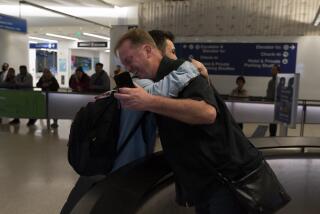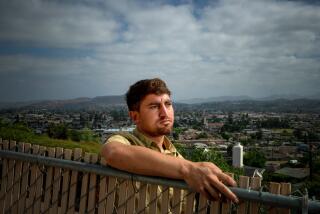Avanesian Told INS of Persecution
- Share via
Immigration officials disclosed Friday that the man who allegedly killed his wife and six children this week by setting fire to their Glendale apartment got into the United States by persuading a refugee officer that his imprisonment in Iran was a case of persecution, not punishment for a crime.
In sworn statements given last August at the refugee processing center in Istanbul, Jorjik Avanesian, 40, denied committing any criminal offenses and characterized his eight-month incarceration as government abuse, said Rosemary Melville, deputy district director of the Los Angeles office of the U.S. Immigration and Naturalization Service.
Avanesian has told police and others, before and after his arrest, that actually he was imprisoned in Iran for stabbing his wife.
Immigration officials made no attempt to independently verify Avanesian’s story, Melville said, citing both the lack of U.S. diplomatic ties to Iran and refugee policy.
“The nature of refugee processing, particularly for somebody from Iran, is that you don’t go back to the country from which they are fleeing for verification . . . out of fear of reprisal being taken against them or other family members,” Melville said.
Bringing his family to Turkey in 1994 shortly after his release from prison, Avanesian first approached the United Nations High Commission on Refugees. In December 1994, the commission referred him to the INS refugee center, recommending the family of eight be granted refugee status.
The Immigration and Naturalization Service took his application and a sworn affidavit that he had no criminal record. An INS officer interviewed Avanesian under oath Aug. 22 and granted his admission request the same day.
At each step, Avanesian denied any criminal activity, Melville said.
“One of the things that was interesting in this case is that the level of detail was so high in the story that was told,” Melville said. “There were no vague answers. . . . He was found to be a credible witness because of the level of detail that he provided to us.”
The family flew to Los Angeles on Sept. 28. Slightly more than a month later, Avanesian was arrested by Glendale police after his wife complained to police that he threw a chair at one of their children and brandished a knife.
The Glendale district attorney’s office declined to prosecute, ordering Avanesian to see a hearing officer who recommended counseling.
He was arrested again Tuesday, several hours after dousing the one-bedroom apartment as his family slept and setting a match to it, killing his wife, three sons and three daughters, ages 4 to 17.
Despite the apparent ease with which Avanesian misled immigration interviewers, Melville said, it would be rash to scrap the system.
“It is safe to say this is a unique case,” she said. “The refugee process is a good process, a fair process, and this is an anomaly. The people who are entering the United States are fleeing persecution, and I don’t think the process should be under attack at this point.”
About 99,000 people enter the United States each year under the refugee program, a spokeswoman for the U.S. State Department said. Last year, refugee status was granted to 978 emigres from Iran.
Citing confidentiality regulations, Melville declined to disclose the specific reason Avanesian gave for being persecuted in Iran.
Eligibility for refugee status is limited to those who face persecution for their race, nationality, religion, political views or membership in a particular social organization. Melville would only say Avanesian built “a link to one of those five grounds.”
A social worker who helped the Avanesians settle in Glendale suggested that the Islamic government of Iran may have persecuted the Avanesians because they are Armenians, a Christian people. The potential for oppression would have been increased by the fact that Avanesian married a Muslim woman who then converted to Christianity, said Svetlana Mollazadeh, director of the International Rescue Committee’s Los Angeles resettlement center.
More to Read
Sign up for Essential California
The most important California stories and recommendations in your inbox every morning.
You may occasionally receive promotional content from the Los Angeles Times.














